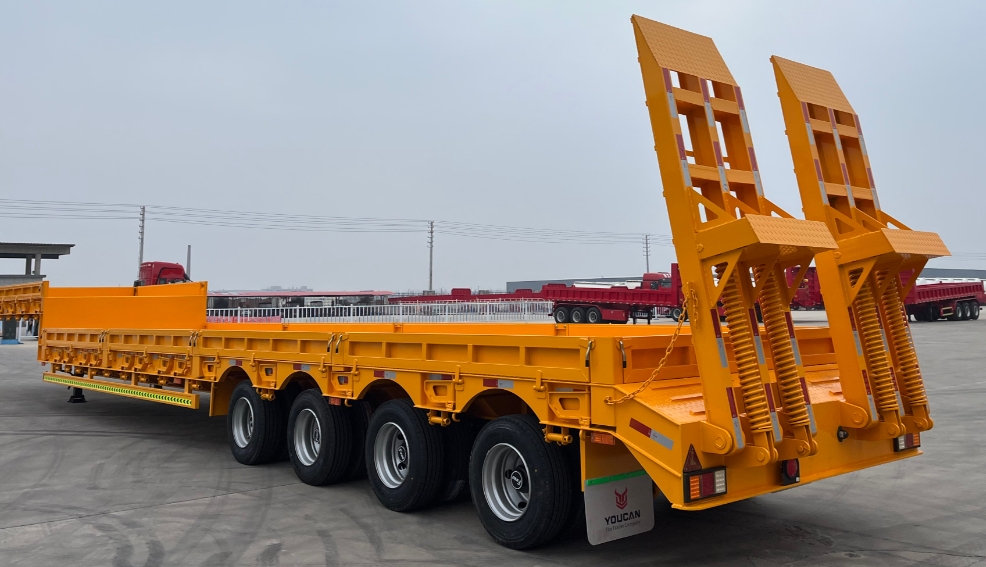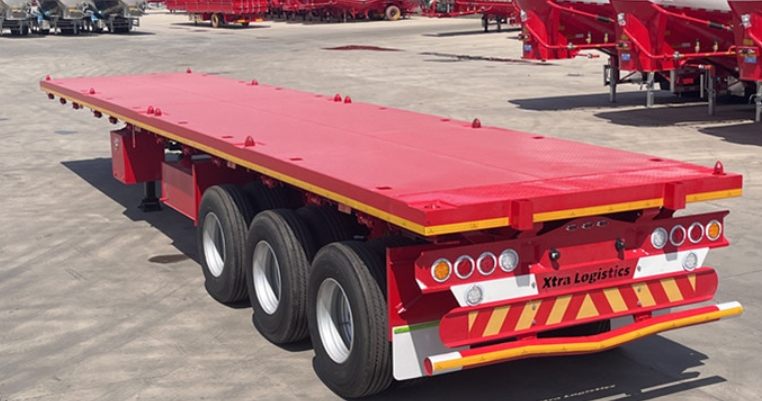Essential Tool in the Freight Industry - Container Chassis
What is a Container Chassis?
A container chassis is a specialized transportation trailer that is designed to transport ISO (International Organization for Standardization) standard intermodal containers. They are an integral part of the global shipping network, connecting vital logistics stages such as road, rail, and sea transportation by allowing for the efficient movement of shipping containers between different carriers and locations.
The structure and design of container chassis:
A standard container chassis typically features a skeletal framework made of high-grade steel. It is a multi-purpose, lightweight, yet durable structure with multiple critical components such as:
Gooseneck: The container chassis often features a gooseneck design at the front end, creating a crucial connection point to the truck tractor or prime mover. The gooseneck allows for easy attachment and ensures safe and secure transportation.
Locking Pins: They are used to connect and securely fasten containers to the chassis. Locking pins are precise, robust, and equipped with safety mechanisms to ensure the container remains firmly in place throughout the journey.
Suspension System: A critical part of the chassis is the suspension system, which helps to provide stability and cushion the movement of the container during transportation. It minimizes the impact and vibrations on the container, ensuring the safe delivery of goods.
Axles: Container chassis are typically built with two or more axles, responsible for bearing the weight of both the chassis and the container. The axles also convert the traction force generated by the prime mover into a rotating force that propels the chassis forward.
Tires: High-quality, durable tires provide the required grip and stability for navigating roads and a smooth transportation experience.
Types of Container Chassis:
There are various types of container chassis designed to cater to different container sizes or transportation requirements. Some common types include:
Single Drop Frame Tank Chassis: Designed specifically for transporting tank containers that hold hazardous liquids or chemicals.
Extendable Chassis: Also known as a telescopic chassis, this type of chassis is designed to adjust its length to accommodate containers of varying sizes.
Combo Chassis: A highly versatile chassis that can be adapted to transport multiple varieties of container sizes, maximizing container transport flexibility.
Tri-axle Chassis: Designed with three axles to accommodate heavier cargo loads and allow for smooth and safe transport.
The Role of the Container Chassis in Logistics Chains:
Shipping containers are standard across the globe, facilitating easy transport between different methods of transport like trucks, railroad cars, and ocean liners. Container chassis are essential to easily and swiftly transfer containers between these modes of transport, creating a seamless logistics chain and accelerating the rate of global trade and cargo movement.Furthermore, the container chassis offers other benefits such as:
Reducing the need for multiple container handling, which minimizes handling costs and risk of damage.
Promoting environmental sustainability by minimizing cargo waste and encouraging efficient use of transportation resources.
In conclusion, the container chassis is an integral part of the worldwide shipping industry. It provides a secure and reliable means for transporting goods and ensures that products can be moved safely, efficiently, and sustainably through various modes of transport.
Standards of a Qualified Container Chassis
Payload Capacity: A qualified container chassis must possess a payload capacity commensurate with the size and weight of shipping containers it will carry, whether they are 20-, 40-, or 45-foot containers. This requirement is essential in ensuring that the chassis can bear the intended load safely.
ISO Certification: To ensure compatibility with the various types of intermodal containers employed in international shipping, a qualified container chassis must conform to ISO standards such as ISO 668, which is responsible for defining intermodal container dimensions and specifications.
Material Quality: A qualified container chassis must be made of high-quality materials, such as high-strength low-alloy steel or corrosion-resistant aluminum, to guarantee longevity as well as structural integrity.
Axle Configuration: A container chassis should be equipped with an adequate number of axles, typically two or three, and maintain a stable center of gravity to support various container sizes and weights while adhering to the legal limitations on axle weight distribution.
Braking System: A qualified container chassis must feature an efficient and dependable braking system that meets industry standards, reducing the risk of accidents and cargo damage.
Lighting and Electrical System: The chassis must be equipped with proper lighting and electrical systems for safety and visibility during transportation, compliant with regional regulations for road and highway use.
Maintenance and Inspection: To maintain its qualification, a container chassis should undergo regular maintenance and inspections as prescribed by the manufacturer or governing regulations. This ensures safe and continued performance throughout its service life.
By adhering to these standards, a container chassis can provide safe, reliable, and efficient transportation for shipping containers, facilitating smoother global trade operations.
Safety Precautions for Using Container Chassis
Container chassis are custom-designed equipment for transporting intermodal containers. They play a crucial role in shipping and cargo handling operations. However, as with any heavy equipment, it is important to follow safety precautions while using container chassis.
Training and Authorization
Make sure all operators have received proper training and are authorized to operate the container chassis.
Provide updated training materials and refreshers as needed.
Ensure understanding of all relevant federal, state, and local safety regulations.
Inspection and Maintenance
Regularly inspect the chassis for structural issues, wear, and damage.
Perform routine maintenance on tires, brakes, electrical systems, and suspension components.
Replace or repair any damaged or worn parts immediately.
Loading and Unloading
Follow proper procedures for loading and unloading containers.
Ensure that the container is securely locked and correctly positioned on the chassis.
Make sure to balance the load so that weight is evenly distributed.
Inspect the twist locks to confirm proper engagement and security.
Personal Protective Equipment (PPE)
Wear appropriate PPE at all times, such as steel-toed shoes, high-visibility clothing, and gloves.
Use safety goggles and hearing protection as needed.
Make sure all PPE is in good condition and replaced when necessary.
Communication and Signaling
Use clear and effective communication when working around container chassis.
Use radios, hand signals, or visual aids to help communicate with other operators and personnel.
Have a spotter or flagger available to guide operators in tight locations or while reversing.
Speed Limit and Stability
Adhere to speed limits and guidelines for safe container chassis operation.
Be aware of the chassis' center of gravity and maintain stability during transport on uneven terrain or in windy conditions.
Slow down and take turns carefully to avoid tipping the container chassis.
Emergency Response
Have an emergency response plan in place and ensure all personnel are familiar with it.
Keep first aid kits, fire extinguishers, and other safety equipment readily available.
Regularly review and update the emergency response plan.
By following these safety precautions, you can minimize risks associated with container chassis operations and help ensure the safety of personnel and cargo.
Container Chassis Application Scenarios
Ports and Terminals: Container chassis are indispensable for transporting containers in ports and terminals. They are used to quickly and efficiently move containers to and from ships, while loading, unloading, or transshipping cargo, ensuring smooth operations and reduced waiting times.
Intermodal Transport: Container chassis are integral to intermodal transportation, which involves the transport of goods using multiple modes (e.g. rail, road, sea). Container chassis facilitate seamless transitions between these modes, making cargo transfers efficient and keeping transport chains running smoothly.
Warehouses and Distribution Centers: Container chassis simplify the process of moving containers to and from warehouses and distribution centers. They enable efficient storage and retrieval, thus optimizing logistics and supply chain management.
Industrial Applications: Many industries, such as manufacturing, construction, and mining, rely on container chassis for transporting equipment, raw materials, and finished products. Container chassis support these industries' supply chain operations, ensuring timely and safe delivery of goods.
Disaster Relief and Emergency Response: In emergency situations, such as natural disasters, container chassis can be essential for transporting aid supplies (e.g., medical equipment, food, and water) to affected areas. Fast and efficient transport can save lives and reduce suffering in these situations.
Container chassis price
When it comes to container chassis pricing, there are various factors to consider in order to find the best possible deal. Here's what you should look for in order to make the most informed decision:
Type of chassis: Container chassis pricing can vary depending on the type, such as a standard tandem 40-foot model, a tri-axle 40-foot model or a gooseneck 20-foot model. Evaluate your needs and compare prices across different types.
Material and construction: The material used to construct the container chassis will have a direct impact on the overall cost. Chassis made from higher grade steel tend to be more expensive but can offer better durability and longevity.
Manufacturing brand: Different brands will offer different price points for container chassis. Take the time to research and compare leading manufacturers to ensure you receive the best quality product within your budget.
New or used: Depending on your budget, consider purchasing a used container chassis. While these may have some wear and tear, you can find great bargains that don't compromise on quality.
Additional features: Certain container chassis models may come with additional features, such as extendable length, anti-lock braking systems, or adjustable axle settings. Consider whether you need these extras and if they justify the additional cost.
Suppliers of Container Chassis
Established in 1999, Youcan Trailers has a wealth of experience in manufacturing semi-trailers and delivering comprehensive trailer solutions for a variety of purposes. Our expertise lies in offering aluminum tankers, fuel tankers, bulk cement tankers, dumper trailers, tipper trailers, stake/sidewall trailers, flatbed trailers, low-bed trailers, container carrier trailers, cargo trailers, and a vast array of other products. With over two decades of experience under our belt, we invite you to contact us for the most recent prices on our new semi-trailers. Exceptional quality paired with competitive pricing awaits you at Youcan Trailers!

 WhatsApp
WhatsApp
 sales@youcantrailer.com
sales@youcantrailer.com
 +8615203709888
+8615203709888


